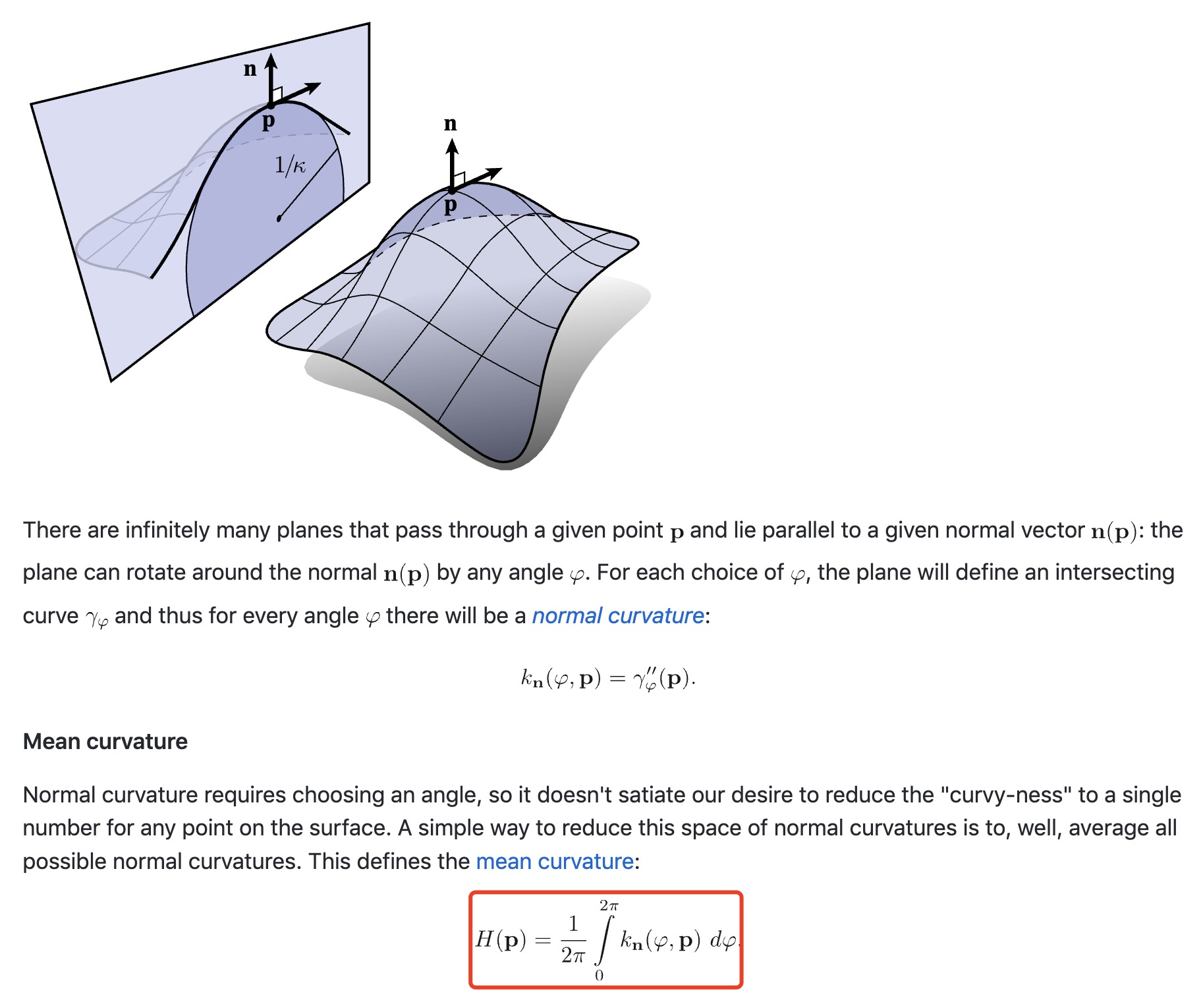An example from Geometry Processing: Curvature
The original equation:

I❤️LA implementation:
`H(p)` = 1/(2π)∫_[0, 2π] `kₙ`(φ, p) ∂φ
where
p ∈ ℝ^3 : point on the surface
`kₙ`: ℝ,ℝ^3 → ℝ : normal curvatureI❤️LA compiled to Python/NumPy/SciPy:
"""
`H(p)` = 1/(2π)∫_[0, 2π] `kₙ`(φ, p) ∂φ
where
p ∈ ℝ^3 : point on the surface
`kₙ`: ℝ,ℝ^3 → ℝ : normal curvature
"""
import numpy as np
import scipy
import scipy.linalg
from scipy import sparse
from scipy.integrate import quad
from scipy.optimize import minimize
class course_curvatureResultType:
def __init__( self, H_left_parenthesis_p_right_parenthesis):
self.H_left_parenthesis_p_right_parenthesis = H_left_parenthesis_p_right_parenthesis
def course_curvature(p, kₙ):
"""
:param :p : point on the surface
:param :kₙ : ℝ,ℝ^3 → ℝ : normal curvature
"""
p = np.asarray(p, dtype=np.float64)
assert p.shape == (3,)
H_left_parenthesis_p_right_parenthesis = 1 / (2 * np.pi) * quad(lambda φ: kₙ(φ, p), 0, 2 * np.pi)[0]
return course_curvatureResultType(H_left_parenthesis_p_right_parenthesis)
def generateRandomData():
p = np.random.randn(3)
def kₙ(p0, p1):
return np.random.randn()
return p, kₙ
if __name__ == '__main__':
p, kₙ = generateRandomData()
print("p:", p)
print("kₙ:", kₙ)
func_value = course_curvature(p, kₙ)
print("return value: ", func_value.H_left_parenthesis_p_right_parenthesis)I❤️LA compiled to MATLAB:
function output = course_curvature(p, k_n)
% output = course_curvature(p, `kₙ`)
%
% `H(p)` = 1/(2π)∫_[0, 2π] `kₙ`(φ, p) ∂φ
%
% where
%
% p ∈ ℝ^3 : point on the surface
% `kₙ`: ℝ,ℝ^3 → ℝ : normal curvature
if nargin==0
warning('generating random input data');
[p, k_n] = generateRandomData();
end
function [p, k_n] = generateRandomData()
p = randn(3,1);
k_n = @k_nFunc;
rseed = randi(2^32);
function tmp = k_nFunc(p0, p1)
rng(rseed);
tmp = randn();
end
end
p = reshape(p,[],1);
assert( numel(p) == 3 );
H_p = 1 / (2 * pi) * integral(@(phi) k_n(phi, p), 0, 2 * pi,'ArrayValued',true);
output.H_p = H_p;
end
I❤️LA compiled to LaTeX:
\documentclass[12pt]{article}
\usepackage{mathdots}
\usepackage[bb=boondox]{mathalfa}
\usepackage{mathtools}
\usepackage{amssymb}
\usepackage{libertine}
\DeclareMathOperator*{\argmax}{arg\,max}
\DeclareMathOperator*{\argmin}{arg\,min}
\usepackage[paperheight=8in,paperwidth=4in,margin=.3in,heightrounded]{geometry}
\let\originalleft\left
\let\originalright\right
\renewcommand{\left}{\mathopen{}\mathclose\bgroup\originalleft}
\renewcommand{\right}{\aftergroup\egroup\originalright}
\begin{document}
\begin{center}
\resizebox{\textwidth}{!}
{
\begin{minipage}[c]{\textwidth}
\begin{align*}
\textit{H(p)} & = \frac{1}{2\pi}\int_{0}^{2\pi} \textit{kₙ}\left( \mathit{φ},\mathit{p} \right) d\mathit{φ} \\
\intertext{where}
\mathit{p} & \in \mathbb{R}^{ 3} \text{ point on the surface} \\
\textit{kₙ} & \in \mathbb{R},\mathbb{R}^{ 3}\rightarrow \mathbb{R} \text{ normal curvature} \\
\\
\end{align*}
\end{minipage}
}
\end{center}
\end{document}
I❤️LA LaTeX output: